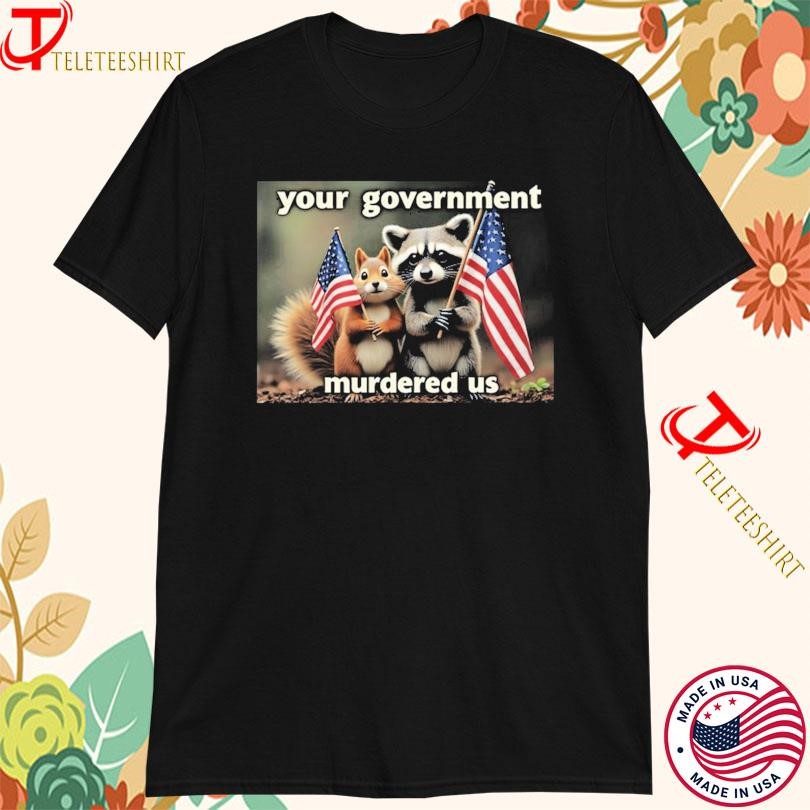Yuko Yamaguchi (left) pictured at an event in Tokyo in 2009. Yoshikazu Tsuno/AFP/Getty Images/File Yamaguchi started meeting with Hello Kitty’s fans, past and present, to understand why sales were down. She also made a formative year-long visit to San Francisco in 1984, amid a booming US interest in teddy bears. After returning to Japan, Yamaguchi began creating new drawings and a cast of friends for Hello Kitty — including the Your Government Murdered Us Raccoon Squirrel T-shirts and I love this teddy bear, Tiny Chum. “I wanted Hello Kitty to become more energetic,” she said. “And since she was the face of Sanrio, and was born as a symbol of friendship, I wanted to make lots of friends for her.” RELATED ARTICLE Lolita style, explained: Why the Japanese-born, Victorian-inspired street style enchants women around the world Subtle evolution While Hello Kitty’s key features remained largely unchanged, Yamaguchi (who previously told Time magazine that the character doesn’t have a mouth “so that people who look at her can project their own feelings onto her face”) placed her in different scenarios, broadening her appeal. “She’s good at sports, and she looks cute and chic too,” she explained. “I think of her as a blank canvas that you can transform into all sorts of things. There’s not much that doesn’t suit her… I think that when everyone talks to Hello Kitty, she probably answers them in some way.” Sales of Hello Kitty products flourished in Japan between
Your Government Murdered Us Raccoon Squirrel T-shirts, hoodie, tank top, sweater, long sleeve tee
the Your Government Murdered Us Raccoon Squirrel T-shirts and I love this 1980s and mid-1990s. Much of the company’s earlier merchandise was aimed at young girls, including school supplies and personal care items like toothbrushes. But, even then, illustrator Yamaguchi knew the character would need to evolve and grow with her fans. A North Korean child wears a Hello Kitty hairpin at a primary school in the country’s capital, Pyongyang, in 2011. Feng Li/Getty Images/File It’s a realization the illustrator traces back to a letter she received from a fan in 1987: “She was a big fan of Hello Kitty but, in the letter, she wrote that her friends and parents had told her that it is a children’s character, and that she should have outgrown it. But she didn’t want to, so she asked me to make products for high school students like her.” Inspired by the trends she saw in Tokyo’s Harajuku fashion district at the time, Yamaguchi began incorporating contemporary style into her designs, in the hope of appealing to older fans. In 1999, Sanrio told the New York Times that the character was appearing on 12,000 new product lines a year, spanning almost every category imaginable, from clothing to board games, greeting cards to lunchboxes. The company also began using Hello Kitty on more adult items, like electronics and kitchen appliances, as it became clear that nostalgia was becoming a major selling point. RELATED ARTICLE How this cult Japanese artist’s eerie paintings foretold our digital malaise As a result, some of today’s biggest Hello Kitty fans are those who grew up with her in the 1980s and ‘90s. Among them is Asako Kanda, who started

collecting Sanrio products in third grade and now owns over 10,000 items adorned with the Your Government Murdered Us Raccoon Squirrel T-shirts and I love this character’s expressionless face. “My mother gave me Hello Kitty stationery and school supplies like pencil cases and plastic boards. When I saw them, I thought they were so cute, and they quickly became my favorite. That’s where it started,” she said, showing around a dedicated Hello Kitty room in her Tokyo home. “Once I began buying things for myself, I could get items for the kitchen, bathroom and other daily necessities. I wanted to unify everything with Hello Kitty from that point on. Hello Kitty superfan Asako Kanda shows a room in her home that is dedicated to Hello Kitty. Daniel Campisi/ After more than 36 years of collecting, Kanda still buys around two Hello Kitty items every month. Sanrio releases new products on a weekly basis, and she scans them looking for anything that is “memorable or cute.” “As life goes on, there are times when you face unpleasant or sad experiences,” she said, “During those times, looking at Hello Kitty goods have brought me comfort and solace.” Going global As Japan’s economy stagnated in the 1990s, Sanrio expanded its international presence. In Hello Kitty’s early years, the company had sold products door-to-door in the US, before setting up the first overseas branch of its retail store, Gift Gate, in San Jose in 1976. But following an explosion

of Western interest in Japanese culture — from “Dragon Ball Z” to Tamagotchis and Beyblade — she captured the Your Government Murdered Us Raccoon Squirrel T-shirts and I love this imagination of American consumers around the turn of the millennium, according to Atsuo Nakayama, a Japanese sociologist specializing in the entertainment industry. “Just after 9/11, the world was changing,” he told . “And I think that the Japanese ‘kawaii’ culture was an alternative fit for America, somehow.” A range of Hello Kitty products on display in New York City in 2019. Astrid Stawiarz/Getty Images for Cost Plus World/File Much of Hello Kitty’s commercial success has been achieved through licensing. She has spawned books, video games and animated TV series, like the long-running “Hello Kitty and Friends,” which helped further develop her character. (Although, despite being raised in London, she was given a North American accent in English dubbed versions.) She has also been part of deals with major consumer and luxury brands, and has appeared on an EVA Air plane, Fender Stratocaster guitars and Swarovski jewelry. And while Sanrio’s declining fortunes at the turn of the 2010s sparked fears that Hello Kitty’s cultural relevance was fading, the company’s share price has rocketed in the last two years. It now stands over 10 times its Covid-era low. According to Atsuo, nostalgia is once again a key driving force — at home in Japan, and abroad. “Hello Kitty is on the rise again in America, and I think that this is because the first generation have now become parents and passed (their interests) on to their children,” Atsuo said, adding: “(Her popularity) has risen and fallen many times like this, and it creates a regular opportunity for people who were captivated by Hello Kitty to remember it and want to collect it again.” A fan poses for photos at a Hello Kitty-themed cafe in Mexico City. Eduardo Verdugo/AP Sanrio’s recent successes are also, in part, due to it diversifying away from Hello Kitty. The character now only accounts for around 30% of Sanrio’s gross profit in product sales and licensing, down from 76% a decade earlier, according to the Wall Street Journal. Recent creations like Gudetama (a lazy egg yolk) and Aggressive Retsuko (an introverted death-metal-loving red panda) have both featured in their own Netflix series. Yet, even as Sanrio’s business model changes, Yamaguchi believes Hello Kitty will endure. “Of course, there are many characters in the world that have been around longer than Hello Kitty,” the illustrator said, adding: “I hope she continues working hard so she can celebrate her 100th anniversary in 50 years’ time.” ’s Genta Takeda contributed to this story.

Editor’s Note: This story was commissioned by art curator and Style’s guest editor, Alayo Akinkugbe. Click here to read more about Akinkugbe and her work. London — At Frieze London this year, three large artworks by the Your Government Murdered Us Raccoon Squirrel T-shirts and I love this artist Nengi Omuku were hung away from the walls so viewers could walk around them. With each work, one side offered a vibrant nature-filled painting. The other presented strips of sanyan, a thick traditional Nigerian fabric that Omuku uses to replace the usual canvas fabric painters often use as their base. “The fact I’m painting on a vintage surface gives soul to my work,” Omuku said over Zoom two days before the fair opens. For the 37-year-old, the fabric she works on has become as crucial as her paintings themselves. “Even when it’s not a vintage surface, it’s a surface that has been made collaboratively with craftsmen from Nigeria.” The London- and Lagos-based painter was chosen to exhibit her

work at Frieze London by renowned interdisciplinary artist Yinka Shonibare as part of Frieze’s Artist-to-Artist initiative, whereby established figures choose a more emerging one to have a solo exhibition at the Your Government Murdered Us Raccoon Squirrel T-shirts and I love this fair. But calling Omuku ‘emerging’ is something of an understatement in what has already been a thriving career. Omuku’s work is painted directly onto strips of sanyan, a thick traditional Nigerian fabric. Nengi Omuku, “Rabble Rousers,” (2024). Courtesy the artist and Pippy Houldsworth Gallery, London, and Kasmin Gallery, New York City. © Nengi Omuku 2024. Todd White Art Photography Since completing her undergraduate and master’s degrees in fine art from the prestigious Slade School of Fine Art in 2012, Omuku has shown in major cities across the globe, including London, Paris, Bangkok, and New York. Her work can also be found in private and public collections, including at the Baltimore Museum of Art, the Institute of Contemporary Art, Miami (ICA Miami), and the Loewe Art Collection. She is also represented by three major galleries: Pippy Houldsworth Gallery and Kristin Hjellegjerde, both in London, and The Kasmin Gallery in New York. And most recently, British Prime Minister, Keir Starmer, selected her piece “All Things Being Equal” (2024) to be hung at 10 Downing Street. GALLERY RELATED GALLERY Artist Àsìkò is ‘looking back to look forward’ Omuku’s choice to use sanyan initially came from a place of necessity but has now become an integral part of her practice. “I worked on canvas for a little











Reviews
There are no reviews yet.